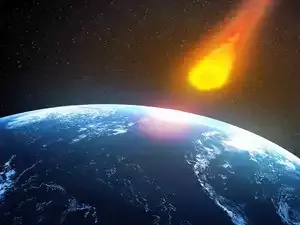A newly discovered asteroid, 2024 YR4, has sparked debate and concern after early calculations suggested it had a 3.1% chance of hitting Earth in December 2032. Over the past few days, however, that figure has been dramatically lowered to just 0.28%, or about 1 in 360.
The asteroid, estimated to be between 40 and 90 metres wide, was briefly ranked as a Level 3 on the Torino Impact Hazard Scale—the highest classification given to any asteroid in years. The scale, introduced in 1999, ranks potential asteroid threats from 0 (no danger) to 10 (certain impact). A Level 3 object, while not an immediate catastrophe, is considered worthy of close scientific monitoring.
Professor Richard Binzel, who developed the scale, explained: “The idea was to be as transparent as possible about what astronomers know. But it’s a bit like being between a rock and a hard place because we want to report what we know to maintain public trust, but we also don’t want to raise any unnecessary anxiety.”
Binzel compared the challenge to tracking a baseball mid-flight: “If you think of it like a baseball game, the amount of information we have to track this asteroid is like trying to figure out where a fly ball will land at the crack of the bat.”
The revised calculations suggest that while 2024 YR4 will pass close to Earth, it is highly unlikely to strike. Still, astronomers will continue monitoring its trajectory over the coming years.
NASA and other agencies have been studying ways to prevent such scenarios. In 2022, NASA’s DART mission successfully altered an asteroid’s trajectory by crashing a spacecraft into it—an approach that could be used for planetary defence if future threats arise.
Binzel recalled: “It ended up being a bit of an embarrassment. It wasn’t that astronomers had made an error, but we didn’t have a good way of communicating uncertainty. So that became the motivation for proposing a simple system for categorising any object for which we can’t immediately rule out that it will miss the Earth for centuries to come.”
Now, with 2024 YR4, scientists are determined to keep the conversation rooted in facts rather than speculation. The European Space Agency noted that while this asteroid briefly held records for the highest impact probability and longest duration above 1%, such classifications are always subject to change with new data.
Seven years remain before 2024 YR4’s closest approach, giving scientists plenty of time to refine their models. While asteroid threats make for dramatic headlines, experts urge the public to stay informed but not panic. NASA and other space agencies will continue tracking such objects, ensuring that if any real danger emerges, action can be taken in time.
For now, 2024 YR4 serves as a reminder of why asteroid monitoring is essential—and how science, not sensationalism, should guide the conversation.
Trump-Modi Meet
The mega MIGA, MAGA plans of India's Modi and US' Trump
Trump says India has more tariffs than others
Trump's 'golden rule' for imposing reciprocal tariffs
Professor Richard Binzel, who developed the scale, explained: “The idea was to be as transparent as possible about what astronomers know. But it’s a bit like being between a rock and a hard place because we want to report what we know to maintain public trust, but we also don’t want to raise any unnecessary anxiety.”
Why the Risk Changed
The dramatic shift in probability numbers isn’t unusual. Scientists refine their calculations as they gather more data. NASA’s latest estimates were based on additional observations made by ground-based telescopes overnight on 19-20 February, allowing astronomers to better understand 2024 YR4’s orbit.Binzel compared the challenge to tracking a baseball mid-flight: “If you think of it like a baseball game, the amount of information we have to track this asteroid is like trying to figure out where a fly ball will land at the crack of the bat.”
The revised calculations suggest that while 2024 YR4 will pass close to Earth, it is highly unlikely to strike. Still, astronomers will continue monitoring its trajectory over the coming years.
What Would Happen if It Hit?
If an asteroid of this size did collide with Earth, the consequences could be severe—though not globally catastrophic. Scientists liken the potential impact to the Tunguska event of 1908, when an explosion over Siberia flattened an area twice the size of New York City. If 2024 YR4 were to strike a densely populated area, damage could be significant. A city-centre hit could shatter windows dozens of miles away, while an ocean impact might trigger large waves.NASA and other agencies have been studying ways to prevent such scenarios. In 2022, NASA’s DART mission successfully altered an asteroid’s trajectory by crashing a spacecraft into it—an approach that could be used for planetary defence if future threats arise.
Public Reactions and Past Lessons
News of 2024 YR4’s fluctuating probabilities has drawn comparisons to past asteroid scares. In 1997, an object named XF11 was initially thought to pose a serious threat, leading to alarmist headlines. Although later calculations ruled out a collision, the incident exposed flaws in how such risks were communicated to the public.Binzel recalled: “It ended up being a bit of an embarrassment. It wasn’t that astronomers had made an error, but we didn’t have a good way of communicating uncertainty. So that became the motivation for proposing a simple system for categorising any object for which we can’t immediately rule out that it will miss the Earth for centuries to come.”
Now, with 2024 YR4, scientists are determined to keep the conversation rooted in facts rather than speculation. The European Space Agency noted that while this asteroid briefly held records for the highest impact probability and longest duration above 1%, such classifications are always subject to change with new data.
Seven years remain before 2024 YR4’s closest approach, giving scientists plenty of time to refine their models. While asteroid threats make for dramatic headlines, experts urge the public to stay informed but not panic. NASA and other space agencies will continue tracking such objects, ensuring that if any real danger emerges, action can be taken in time.
For now, 2024 YR4 serves as a reminder of why asteroid monitoring is essential—and how science, not sensationalism, should guide the conversation.








